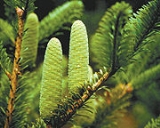
Abies beshanzuensis
Encyclopedia
Abies beshanzuensis is a species of conifer in the family Pinaceae
. It is endemic to Baishanzu Shan in southern Zhejiang
province in eastern China
, where it grows at 1,850 m altitude and is threatened by collection and climate change
. Abies beshanzuensis is classified as critically endangered by the IUCN Red List
.
It was discovered in 1963 on the summit of Baishanzu Shan (1,857 m), where only seven trees were found. Three of these were dug up and moved to Beijing Botanical Garden
, where they died. By 1987, only three trees were left in the wild, making it the rarest conifer in the world. New planting of grafted plants on Baishanzu Shan and other nearby sites has shown some success, but the species remains critically endangered.
It is a tree growing to 15–17 metres tall, with a broad conic crown and a trunk up to 0.8 metres diameter. The shoots are stout, pale yellow-brown, hairless or slightly hairy. The leaves are linear, 1.5–4 cm long and 2.5–3.5 mm wide, glossy green above, and with two white stoma
tal bands below. The cones
are narrow cylindric-conic, bright green when immature, ripening pale yellow-brown, 6–12 cm long and 3–4 cm wide, with exserted and reflexed bracts.
It is closely related to Abies firma from southern Japan
, placed with it as the only two members of Abies subsect. Firmae. The species Abies ziyuanensis
is included in Abies beshanzuensis as a variety by some botanists, though others place this species in a different subsection of the genus, Abies subsect. Holophyllae.
Pinaceae
Pinaceae are trees or shrubs, including many of the well-known conifers of commercial importance such as cedars, firs, hemlocks, larches, pines and spruces. The family is included in the order Pinales, formerly known as Coniferales. Pinaceae are supported as monophyletic by its protein-type sieve...
. It is endemic to Baishanzu Shan in southern Zhejiang
Zhejiang
Zhejiang is an eastern coastal province of the People's Republic of China. The word Zhejiang was the old name of the Qiantang River, which passes through Hangzhou, the provincial capital...
province in eastern China
China
Chinese civilization may refer to:* China for more general discussion of the country.* Chinese culture* Greater China, the transnational community of ethnic Chinese.* History of China* Sinosphere, the area historically affected by Chinese culture...
, where it grows at 1,850 m altitude and is threatened by collection and climate change
Climate change
Climate change is a significant and lasting change in the statistical distribution of weather patterns over periods ranging from decades to millions of years. It may be a change in average weather conditions or the distribution of events around that average...
. Abies beshanzuensis is classified as critically endangered by the IUCN Red List
IUCN Red List
The IUCN Red List of Threatened Species , founded in 1963, is the world's most comprehensive inventory of the global conservation status of biological species. The International Union for Conservation of Nature is the world's main authority on the conservation status of species...
.
It was discovered in 1963 on the summit of Baishanzu Shan (1,857 m), where only seven trees were found. Three of these were dug up and moved to Beijing Botanical Garden
Beijing Botanical Garden
The Beijing Botanical Garden is a botanical garden situated in the northwestern outskirts of Beijing, China between Xiangshan Park and Jade Spring Mountain in the Western Hills.-History:...
, where they died. By 1987, only three trees were left in the wild, making it the rarest conifer in the world. New planting of grafted plants on Baishanzu Shan and other nearby sites has shown some success, but the species remains critically endangered.
It is a tree growing to 15–17 metres tall, with a broad conic crown and a trunk up to 0.8 metres diameter. The shoots are stout, pale yellow-brown, hairless or slightly hairy. The leaves are linear, 1.5–4 cm long and 2.5–3.5 mm wide, glossy green above, and with two white stoma
Stoma
In botany, a stoma is a pore, found in the leaf and stem epidermis that is used forgas exchange. The pore is bordered by a pair of specialized parenchyma cells known as guard cells that are responsible for regulating the size of the opening...
tal bands below. The cones
Conifer cone
A cone is an organ on plants in the division Pinophyta that contains the reproductive structures. The familiar woody cone is the female cone, which produces seeds. The male cones, which produce pollen, are usually herbaceous and much less conspicuous even at full maturity...
are narrow cylindric-conic, bright green when immature, ripening pale yellow-brown, 6–12 cm long and 3–4 cm wide, with exserted and reflexed bracts.
It is closely related to Abies firma from southern Japan
Japan
Japan is an island nation in East Asia. Located in the Pacific Ocean, it lies to the east of the Sea of Japan, China, North Korea, South Korea and Russia, stretching from the Sea of Okhotsk in the north to the East China Sea and Taiwan in the south...
, placed with it as the only two members of Abies subsect. Firmae. The species Abies ziyuanensis
Abies ziyuanensis
Abies ziyuanensis is a species of fir, a conifer in the Pinaceae family.It is found only in China.-Source:* Conifer Specialist Group 1998. . Downloaded on 10 July 2007....
is included in Abies beshanzuensis as a variety by some botanists, though others place this species in a different subsection of the genus, Abies subsect. Holophyllae.

